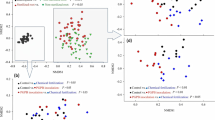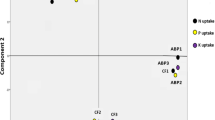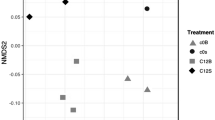Abstract
Background and aims
A glasshouse experiment was conceived to assess the role of a bacterial consortium (Pseudomonas composti SDT3, Aeromonasaquariorum SDT 13 and Bacillus sp. SDT14) isolated from the rizhosphere of S. densiflora on its growth and physiological tolerance to the physicochemical properties of marsh soils.
Methods
Two inoculation treatments (with and without inoculation) in combination with two soil types (from Piedras and Odiel marshes, SW Spain) were assigned for 50 days. Growth parameters, combined with measurements of gas exchange, efficiency of PSII biochemistry, photosynthetic pigments and leaf water content were measured. In addition, the accumulation of nutrients and trace elements were determined.
Results
The inoculation improved growth of S. densiflora through a beneficial effect on its photochemical apparatus due to its impact on chlorophyll concentration. This enhancement happened under both soil conditions and was mainly reflected in a greater length and diameter of roots. Also, inoculation favoured leaf water content through the decline in stomatal conductance and increment in root-to-shoot ratio. Moreover, this consortium was able to stimulate ion accumulation in roots and leaves.
Conclusions
Selected rhizospheric bacteria appear to play a significant role in S. densiflora growth response and tolerance to the physicochemical properties of marshes soils.






Similar content being viewed by others
References
Ahemad M, Khan MS (2011) Functional aspects of plant growth promoting rhizobacteria: recent advancements. Insight Microbiol 1:39–54
Andrades-Moreno L, del Castillo I, Parra R, Doukkali B, Redondo-Gómez S, Pérez-Palacios P, Caviedes MA, Pajuelo E, Rodríguez-Llorente ID (2014) Prospecting metal resistant plant growth promoting rhizobacteria for rhizoremediation of metal contaminated estuaries using Spartina densiflora. Environ Sci Pollut R 21:3713–3721
Bharti N, Barnawal D, Awathi A, Yadav A, Kalra A (2014) Plant growth promoting rhizobacteria alleviate salinity induced negative effects on growth, oil content and physiology status in Menthaarvensis. Acta Physiol Plant 36:45–60
Bhattacharyya PN, Jha DK (2012) Plant growth-promoting rhizobacteria(PGPR): emergence in agriculture. World J Microbiol Biotechnol 28:1327–1350
Bouyoucos GJ (1936) Directions for making mechanical analyses of soil by the hydrometer method. Soil Sci 42:225–229
Boyer JS (1985) Water transport. Annual review of plant physiology and plant. Mol Biol 36:473–516
Bresson J, Varoquaux F, Bontpart T, Touraine B, Vile D (2013) The PGPR strain Phyllobacteriumbrassicacearum STM196 induces a reproductive delay and physiological changes that result in improved drought tolerance in Arabidopsis. New Phytol 200:558–569
Burd G, Dixon DG, Glick B (2000) Plant growth promoting bacteria that decreases heavy metal toxicity in plants. Can J Microbiol 46:237–245
Caslake L, Harris S, Williams C, Waters N (2006) Mercury-resistant bacteria associated with macrophytes from a polluted lake. Water Air Soil Pollut 174:93–105
Chang P, Gerhardt KE, Huang XD, Yu XM, Glick BR, Gerwing PD, Greenberg BM (2014) Plant Growth-Promoting bacteria facilitate the growth of Barley and Oats in salt-impacted soil: implications for phytoremediation of saline soils. Int J Phytoremediation 16:1133–1147
Chookietwattana K, Maneewan K (2012) Selection of efficient salt-tolerant bacteria containing ACC deaminase for promotion of tomato growth under salinity stress. Soil Environ 31:30–36
de Souza MP, Huang CPA, Chee N, Terry N (1999) Rhizosphere bacteria enhance the accumulation of selenium and mercury in wetland plants. Planta 209:259–263
Glick BR (2003) Phytoremediation: synergistic use of plants and bacteria to clean up the environment. Biotechnol Adv 21:383–393
Gururani MA, Upadhyaya CP, Baskar V, Venkatesh J, Nookaraju A, Park SW (2013) Plant growth-promoting rhizobacteria enhance abiotic stress tolerance in Solanumtuberosum through inducing changes in the expression of Ros-scavenging enzymes and improved photosynthetic performance. J Plant Growth Regul 32:245–258
Hoagland D, Arnon DI (1938) The water culture method for growing plants without soil. Cal Agric Exp St Bull 347:1–39
Li WC, Ye ZH, Wong MH (2007) Effects of bacteria on enhanced metal uptake of the Cd/Zn hyperaccumulating plant, Sedum alfredii. J Exp Bot 58:4173–4182
Lichtenthaler HK (1987) Chlorophylls and carotenoids: pigments of photosynthetic biomembranes. Methods Enzymol 148:350–382
Mateos-Naranjo E, Redondo-Gómez S, Silva J, Santos R, Figueroa ME (2007) Effect of prolonged flooding on the invader Spartina densiflora Brong. J Aquat Plant Manage 45:121–123
Mateos-Naranjo E, Redondo-Gómez S, Cambrollé-Silva J, Figueroa ME (2008a) Growth and photosynthetic responses to copper stress of an invasive Cordgrass, Spartina densiflora. Mar Environ Res 66:459–465
Mateos-Naranjo E, Redondo-Gómez S, Cambrollé-Silva J, Luque-Palomo Mª T, Figueroa ME (2008b) Growth and photosynthetic responses to zinc stress of an invasive Cordgrass, Spartina densiflora. Plant Biol 10:754–762
Mateos-Naranjo E, Redondo-Gómez S, Luque CJ, Castellanos EM, Davy AJ, Figueroa ME (2008c) Environmental limitations on recruitment from seed in invasive Spartina densiflora on a southern European salt marsh. Estuar Coast Shelf Sci 79:727–732
Mateos-Naranjo E, Andrades-Moreno L, Redondo-Gómez S (2011) Comparison of germination, growth, photosynthetic responses and metal uptake between three populations of Spartina densiflora under different soil pollution conditions. Ecotox Environ Safe 74:2040–2049
Mateos-Naranjo E, Andrades-Moreno L, Davy AJ (2013) Silicon alleviates deleterious effects of high salinity on the halophytic grass Spartina densiflora. Plant Physiol Biochem 63:115–121
Maxwell K, Johnson G (2000) Chlorophyll fluorescence a practical guide. J Exp Bot 51:659–668
Melis A (1999) Photosystem II damage and repair cycle in chloroplasts: what modulates the rate of photodamage in vivo? Trends Plants Sci 4:130–135
Nable RO, Barakiva A, Loneragan JF (1984) Functional manganese requirement and its use a critical value for diagnosis of manganese deficiency in subterranean clover (Trifolium subterraneum L. CV. Seaton Park). Ann Bot-London 54:39–49
Ono TA, Noguchi T, Inoue Y, Kusunoki M, Matsushita T, Oyanagi H (1992) X-ray detection of the period-four cycling of the manganese cluster in photosynthetic water oxidizing enzyme. Science 258:1335–1337
Patten CL, Glick BR (2002) Role of Pseudomonas putidaindoleacetic acid in development of the host plant root system. Appl Environ Microbiol 68:3795–3801
Rincon A, Valladares F, Gimeno TE, Pueyo JJ (2008) Water stress responses of two Mediterranean tree species influenced by native soil microorganisms andinoculation with a plant growth promoting rhizobacterium. Tree Physiol 28:1693–1701
Ruiz-Sanchez M, Armada E, Munoz Y, García de Salamone IE, Aroca R, Ruiz-Lozano JM, Azcon R (2011) Azospirillum and arbuscular mycorrhizal colonization enhance rice growth and physiological traits under well watered and drought conditions. J Plant Physiol 168:1031–1037
Tardieu F (2012) Any trait or trait related allele can confer drought tolerance: just design the right drought scenario. J Exp Bot 63:25–31
Teixeira C, Almeida CMR, da Silva MN, Bordalo AA, Mucha AP (2014) Development of autochthonous microbial consortia for enhanced phytoremediation of salt-marsh sediments contaminated with cadmium. Sci Total Environ 493:757–765
Thompson IP, Bailey MJ, Fenlon JS, Fermor TR, Lilley AK, Lynch JM, McCormack PJ, McQuilken MP, Purdy KJ, Rainey PB, Whipps JM (1993) Quantitative and qualitative seasonal-changes in the microbial community from the phyllosphere of sugar-beet (Beta vulgaris). Plant Soil 150:177–191
Tsavkelova EA, Cherdyntseva TA, Botina SG, Netrusov AI (2007) Bacteria associated with orchid roots and microbial production of auxin. Microbiol Res 162:69–76
Wani PA, Khan MS, Zaidi A (2007) Effect of metal tolerant plant growth promoting Bradyrhizobium sp. (vigna) on growth, symbiosis, seed yield and metal uptake bygreengram plants. Chemosphere 70:36–45
Werner C, Correia O, Beyschlag W (2002) Characteristic patterns of chronic and dynamic photoinhibition of different functional groups in a Mediterranean ecosystem. Funct Plant Biol 29:999–1011
Acknowledgments
We are grateful to Antonio Ruiz Rico for revision of the English text of this manuscript, Cristian Gómez for technical assistance and Antonio Diaz-Espejo for his altruistic help in lending some of the equipments. We also thank the Spanish Science and Technology Ministry and Junta de Andalucía for their support (projects CTM2008-04453 and RNM07274) and Seville University Glasshouse General Services for their collaboration. JM acknowledges financial support from the FPU Grant (Ref. AP2012-1809) awarded by Ministerio de Educación, Cultura y Deporte, Spain.
We also thank the useful comments of Editor who helped to improve the final version of the manuscript.
Conflict of interest
The authors declare that they have no conflict of interest.
Author information
Authors and Affiliations
Corresponding author
Additional information
Responsible Editor: Timothy J. Flowers.
Rights and permissions
About this article
Cite this article
Mateos-Naranjo, E., Mesa, J., Pajuelo, E. et al. Deciphering the role of plant growth-promoting rhizobacteria in the tolerance of the invasive cordgrass Spartina densiflora to physicochemical properties of salt-marsh soils. Plant Soil 394, 45–55 (2015). https://doi.org/10.1007/s11104-015-2504-7
Received:
Accepted:
Published:
Issue Date:
DOI: https://doi.org/10.1007/s11104-015-2504-7




